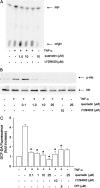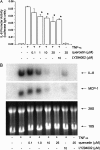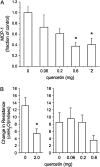Quercetin blocks airway epithelial cell chemokine expression
- PMID: 16794257
- PMCID: PMC2643278
- DOI: 10.1165/rcmb.2006-0149OC
Quercetin blocks airway epithelial cell chemokine expression
Abstract
Quercetin (3,3',4',5,7-pentahydroxyflavone), a dietary flavonoid, is an inhibitor of phosphatidylinositol (PI) 3-kinase and potent antioxidant. We hypothesized that quercetin blocks airway epithelial cell chemokine expression via PI 3-kinase-dependent mechanisms. Pretreatment with quercetin and the PI 3-kinase inhibitor LY294002 each reduced TNF-alpha-induced IL-8 and monocyte chemoattractant protein (MCP)-1 (also called CCL2) expression in cultured human airway epithelial cells. Quercetin also inhibited TNF-alpha-induced PI 3-kinase activity, Akt phosphorylation, intracellular H(2)O(2) production, NF-kappaB transactivation, IL-8 promoter activity, and steady-state mRNA levels, consistent with the notion that quercetin inhibits chemokine expression by attenuating NF-kappaB transactivation via a PI 3-kinase/Akt-dependent pathway. Quercetin also reduced TNF-alpha-induced chemokine secretion in the presence of the transcriptional inhibitor actinomycin D, while inducing phosphorylation of eukaryotic translation initiation factor (eIF)-2alpha, suggesting that quercetin attenuates chemokine expression by post-transcriptional as well as transcriptional mechanisms. Finally, we tested the effects of quercetin in cockroach antigen-sensitized and -challenged mice. These mice show MCP-1-dependent airways hyperresponsiveness and inflammation. Quercetin significantly reduced lung MCP-1 and methacholine responsiveness. We conclude that quercetin blocks airway cell chemokine expression via transcriptional and post-transcriptional pathways.
Figures







Similar articles
-
Differential involvement of phosphoinositide 3-kinase/Akt in human RPE MCP-1 and IL-8 expression.Invest Ophthalmol Vis Sci. 2004 Jun;45(6):1887-96. doi: 10.1167/iovs.03-0608. Invest Ophthalmol Vis Sci. 2004. PMID: 15161854
-
PI 3 kinase-dependent Akt kinase and PKCepsilon independently regulate interferon-gamma-induced STAT1alpha serine phosphorylation to induce monocyte chemotactic protein-1 expression.Cell Signal. 2006 Apr;18(4):508-18. doi: 10.1016/j.cellsig.2005.05.022. Epub 2005 Sep 12. Cell Signal. 2006. PMID: 16157472
-
Aberrantly activated EGFR contributes to enhanced IL-8 expression in COPD airways epithelial cells via regulation of nuclear FoxO3A.Thorax. 2013 Feb;68(2):131-41. doi: 10.1136/thoraxjnl-2012-201719. Epub 2012 Oct 25. Thorax. 2013. PMID: 23099361 Free PMC article.
-
Coordinated post-transcriptional regulation of the chemokine system: messages from CCL2.J Interferon Cytokine Res. 2014 Apr;34(4):255-66. doi: 10.1089/jir.2013.0149. J Interferon Cytokine Res. 2014. PMID: 24697203 Free PMC article. Review.
-
Interleukin-8: a very important chemokine of the human airway epithelium.Am J Physiol Lung Cell Mol Physiol. 2002 Oct;283(4):L688-9. doi: 10.1152/ajplung.00146.2002. Am J Physiol Lung Cell Mol Physiol. 2002. PMID: 12225944 Review. No abstract available.
Cited by
-
Quercetin and Resveratrol Differentially Decrease Expression of the High-Affinity IgE Receptor (FcεRI) by Human and Mouse Mast Cells.Molecules. 2022 Oct 8;27(19):6704. doi: 10.3390/molecules27196704. Molecules. 2022. PMID: 36235240 Free PMC article.
-
Quercetin and kaempferol suppress immunoglobulin E-mediated allergic inflammation in RBL-2H3 and Caco-2 cells.Inflamm Res. 2010 Oct;59(10):847-54. doi: 10.1007/s00011-010-0196-2. Epub 2010 Apr 13. Inflamm Res. 2010. PMID: 20383790
-
A comprehensive perspective of traditional Arabic or Islamic medicinal plants as an adjuvant therapy against COVID-19.Saudi J Biol Sci. 2023 Mar;30(3):103561. doi: 10.1016/j.sjbs.2023.103561. Epub 2023 Jan 13. Saudi J Biol Sci. 2023. PMID: 36684115 Free PMC article. Review.
-
Effects of Allium cepa and Its Constituents on Respiratory and Allergic Disorders: A Comprehensive Review of Experimental and Clinical Evidence.Evid Based Complement Alternat Med. 2021 Sep 11;2021:5554259. doi: 10.1155/2021/5554259. eCollection 2021. Evid Based Complement Alternat Med. 2021. PMID: 34552650 Free PMC article. Review.
-
Monocyte chemoattractant protein-1 (MCP-1): an overview.J Interferon Cytokine Res. 2009 Jun;29(6):313-26. doi: 10.1089/jir.2008.0027. J Interferon Cytokine Res. 2009. PMID: 19441883 Free PMC article. Review.
References
-
- National Toxicology Program. Toxicology and carcinogenesis studies of quercetin (CAS No. 117–39–5) in F344 rats (feed studies). Natl Toxicol Program Tech Rep Ser 1992;409:1–171. - PubMed
-
- Agullo G, Gamet-Payrastre L, Manenti S, Viala C, Remesy C, Chap H, Payrastre B. Relationship between flavonoid structure and inhibition of phosphatidylinositol 3-kinase: a comparison with tyrosine kinase and protein kinase C inhibition. Biochem Pharmacol 1997;53:1649–1657. - PubMed
-
- Huang Y-T, Hwang J-J, Lee P-P, Ke F-C, Huang J-H, Huang C-J, Kandaswami C, Middleton E Jr, Lee M-T. Effects of luteolin and quercetin, inhibitors of tyrosine kinase, on cell growth and metastasis-associated properties in A431 cells overexpressing epidermal growth factor receptor. Br J Pharmacol 1999;128:999–1010. - PMC - PubMed
-
- Peet GW, Li J. IkappaB kinases alpha and beta show a random sequential kinetic mechanism and are inhibited by staurosporine and quercetin. J Biol Chem 1999;274:32655–32661. - PubMed
Publication types
MeSH terms
Substances
Grants and funding
LinkOut - more resources
Full Text Sources
Other Literature Sources
Research Materials
Miscellaneous

